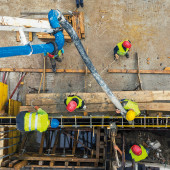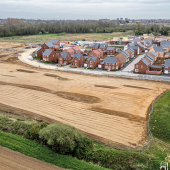Road to registration

Three CABE members give their experiences of the new CABE Building Inspector Competence Assessment Scheme (CBICAS) to Matt Lamy.
One of the key focuses of both the Building Safety Act 2022 and the work of the Building Safety Regulator (BSR) is to improve competence levels among everybody working in the built environment. To achieve this, there has been a transformational change in the way compliance of building work is understood. Rather than simply complying with proscriptive regulations, as had become the predominant understanding previously, it is now understood that the focus must be on meeting practical outcomes – that is, is a building fit for purpose and able to protect the health, safety, welfare and amenity of people? The role of building inspectors is fundamental to meeting these objectives.
Building inspectors were asked to register with the BSR by April 2024 (although this has been extended to 6 July) after having certified their fulfilment of the competences listed in the new Building Inspector Competence Framework (BICoF). To do this, they have to successfully complete a competence certification scheme delivered by a BSR-approved provider. CABE provides one such scheme – the CABE Building Inspector Competence Assessment Scheme (CBICAS) – and is the only professional body to do so.

Richard Cymler C.Build E MCABE, Building Control Director Midlands, SWECO
I have been employed in the building control field for 40 years and the reason I applied to CBICAS is because it was a legal requirement if I wanted to continue my career carrying out restricted functions. I’ve also been a CABE member for about 30 years or so. Of the three competence certification schemes available, I opted for CABE as I had sufficient trust in the organisation to choose it ahead of the other options.
CABE’s CBICAS competence assessment was a three-stage application. Stage 1 was a career résumé and a general explanation of my experience. This initial application stage doesn’t go into any great detail – it’s just to prove that you appear competent for the class of building inspector you are applying for. I initially applied for Class 3 building inspector. The reason I did so is because you must be registered with the BSR at the class of project that you are involved with – some of the projects I am involved with are Class 3 rather than Class 2. The next class, Class 4, is a recognition that you are managing surveyors. However, unlike the requirement to be registered at Classes 1, 2 or 3 to carry out your job legally, there is no legal requirement for anybody to register at Class 4.
At Stage 2 of CBICAS, I had to submit case studies of two projects – one residential and one non-residential – that fitted the Class 3 criteria. I had to explain what my involvement was and demonstrate that I had full knowledge and was fully responsible for them. There was also a second document I had to submit that listed all the competencies in BICoF that BSR stipulates need to be demonstrated and how I satisfied them. That was all accepted by CABE, and then came the final stage – an interview with two assessors.
After I submitted my application for Class 3 registration, CABE came back and said they thought I should go for Class 4 as I do manage surveyors. I asked if there was any more paperwork involved, and happily there wasn’t. The people at CABE explained that Stage 3 – the interview – would just have a different structure and they would tailor the questions accordingly. At that point I said that I would go for Class 4.
For some people this interview might be the most daunting stage, but I actually found the paperwork to be the least enjoyable part. The interview was done over a Teams call and I thought it was very professionally handled and the people involved helped me to feel relaxed. It wasn’t seen as a grilling. It was more of a discussion, so I felt that was conducted very well. After the interview I was informed by CABE that I had been successful, and I was then able to register with the BSR.
Overall, I would say CBICAS was a challenging experience, especially doing the paperwork. However, I fully appreciate that if the scheme was too easy or too full of holes then the BSR wouldn’t accept it, so it was suitably comprehensive. On a scale of one to ten, I’d be giving CABE and the staff involved at least a score of eight. I felt well supported, and the help they gave and the discussions we had were all perfect. The only issues were the timescales involved – everybody was racing for the 6 April deadline, which made it difficult for a lot of people.
Different classes
There are four classes of building inspector that an applicant can register with the BSR for:
Class 1: Trainee. This class is suitable for a person working in building control who cannot, on entry to registration, demonstrate the required competence to work unsupervised. Registering for Class 1 must be done directly with the BSR.
Class 2: Building Inspector. Class 2 building inspectors perform restricted activities and advise on restricted functions within the limitations of their registration. This is a broad class, which covers all building types other than non-standard and higher-risk buildings (HRBs).
Class 3: Building Inspector. Class 3 building inspectors are those registered with the additional knowledge and experience required to carry out the restricted activities, and advise on restricted functions in relation to all building types, including non-standard and/or HRBs.
Class 4: Building Inspector (Technical Manager). Class 4 building inspectors are individuals who, in addition to holding the competence of a Class 2 or Class 3 building inspector, are responsible for technical management of a building control team.

Rupert Hanson MCABE IEng, Building Inspector, Owl Building Control Solutions
My route towards and then through CBICAS and the building inspector registration process was a little different because I was already working towards Chartered Membership with CABE. I had actually booked my CABE interview to upgrade to become a Chartered Member when I received an email asking if I would like to do a blended application, which meant I was able to apply to be a Chartered Member and complete my CBICAS grading at the same time. I said yes.
I am relatively fresh to this side of the industry. Although I was a builder for 15 years, I decided in my early 30s that I should probably make a change. I managed to get an HNC in my spare time while still being on the tools, then I was employed with Owl Building Control. I became an Associate Member of CABE four years ago. Because I see myself as still being on my training journey, the building inspector registration process felt like just another thing that I had to achieve.
The CBICAS experience was superb. The communication was excellent: I never felt like I was left waiting for information or more instructions. Everything was really clear and concise. While I wouldn’t necessarily say it was a pleasure, it was certainly as streamlined a process as I think was possible, which made it far less stressful.
The timings given to me by CABE at any point were also always adhered to. If they told me something was going to occur within a certain time, it always did occur. That was great – it left me feeling confident in the process and it took a bit of the anxiety away. Of course, there was a fair deal of stress because I still had to do the work, but CABE pitched it so well.
I mentioned the timing, but another way that my experience was probably slightly different to most people was that, three years ago, I pinpointed a project that I thought would be fantastic for my technical report towards becoming chartered with CABE. I had essentially already started writing my technical report when the issue of building inspector registration came up.
Funnily enough, for CABE chartership, the technical report word limit is 4,000 words, but with CBICAS it is 6,000 words. When I was looking purely at getting chartered, I’d written about 5,000 words and I really couldn’t find a way to reduce it. So, when I heard it was a 6,000-word limit for CBICAS, I’m probably the only person who actually thought: brilliant!
Once I had handed all that in, I then had to wait for the interview date. I was partly excited, but when I got confirmation of the date I suddenly found myself dreading the prospect. I did the interview in January – I was really, really early in the CBICAS scheme – and I actually had a good time. The people who chatted with me were great and I think they were completely fair and balanced in their approach.
I got an email saying I’d passed the interview and, with that, I got my CBICAS registration for Class 2A, B and D (see Different Classes). I’d also got my MCABE Chartered Membership, and – because CBICAS is also an Engineering Council approved standard – I also got Incorporated Engineer status. It was a triple whammy. It was all quite emotional for me because I had essentially started out in this business as a labourer, so I felt I had done pretty well!

Joshua Katihrob MCABE IEng, Building Inspector, Meridian Consult
Like Hanson, my route through CBICAS and the building inspector registration process fitted nicely into my own experience at the time. I qualified from university in 2021. I then became a Chartered Member of CABE in 2023, so I was used to writing reports when the new registration process came along.
The written stages of CBICAS were similar to the chartership process. I had to do a bit of research to ensure I included the information that CABE required; however, they provided a lot of the reading material that explained what was needed. That made the process much more straightforward.
Stage 2 involved going through the competencies based on the BICoF and I had to evidence how I met them. After completing that section, it was time to write my report showcasing some of the projects I have worked on and evidencing my competency throughout those. Again, the report style of writing was very similar to what I had been doing at university and during my chartership application. I wasn’t thrilled at the idea of going through the process again, but I saw it as a compulsory yet positive career step.
Finding the time to do it all was probably the trickiest aspect – it does require a fair bit of time. I did all my work for CBICAS on a Saturday morning: I’d wake at 6am and work on it until 9am. I did that every Saturday, and some Sundays as well, from October 2023 until March this year. I reasoned that sometimes you must make a short-term sacrifice for a long-term gain.
After Stage 2, I was hesitant at the idea of another interview. When I first tried to achieve chartership in 2022, I had failed at the interview stage and, although I succeeded on my second attempt in 2023, it was still quite intimidating going through a similar interview for the third time in 18 months.
The two assessors who did it were great and were really welcoming. It wasn’t like being put under a spotlight and made to answer questions – it was more of a conversation with colleagues, while they still asked the required questions. If I found myself unable to remember an answer, they assisted by rewording the question. This was beneficial as the interview process makes you nervous and you can forget even the most obvious of answers.
Overall, I think CABE has done a great job with CBICAS. My fear was, when the building inspector registration requirement came along, CABE chartership wouldn’t mean as much as it previously had – because to be a Chartered Building Engineer was the gold standard. However, CABE has mapped the two processes together and I feel, with the introduction of CBICAS, it has made a new gold standard.
I welcome the registration process as I think it is a great way to level the playing field and evidence our competency, irrespective of age. I am glad to see that as building inspectors we are now being viewed as professionals in our own right, and we now have additional certification to prove it.
Thank you CABE for stepping up and providing a suitable route for building inspectors to show our competency and to allow us to register with the BSR.

Building inspector registration will continue beyond 6 July, but there are two important matters to note: firstly, the deadline to benefit from the transitional provisions for registration is midnight 5 July. This means that, secondly, if you are not certified and registered from 6 July, you will need to work under supervision of a suitably qualified building inspector taking into account guidance published by CABE and the BSR.
To find out more about CBICAS, please visit https://www.cbuilde.com/page/CBICAS_Docs









